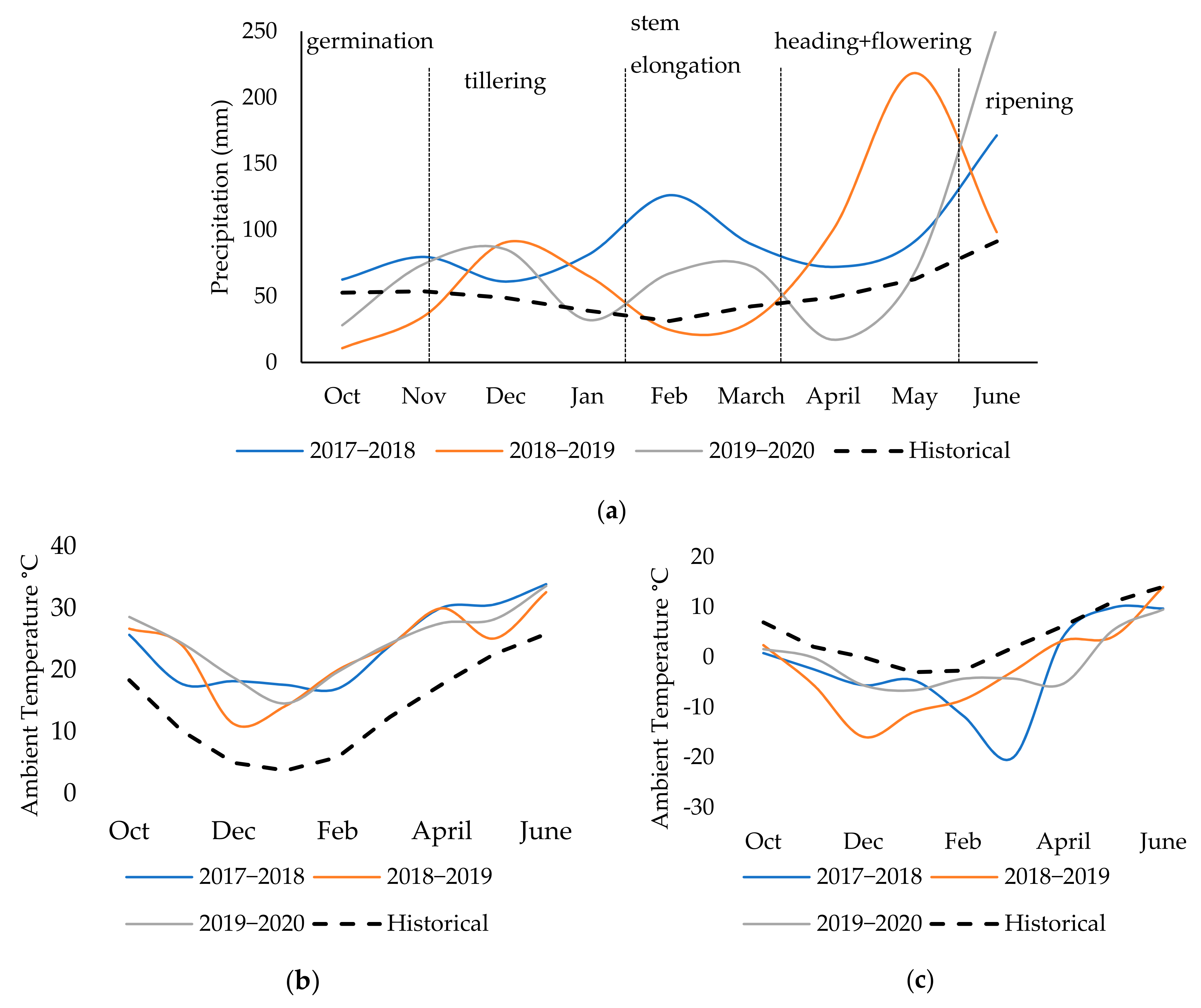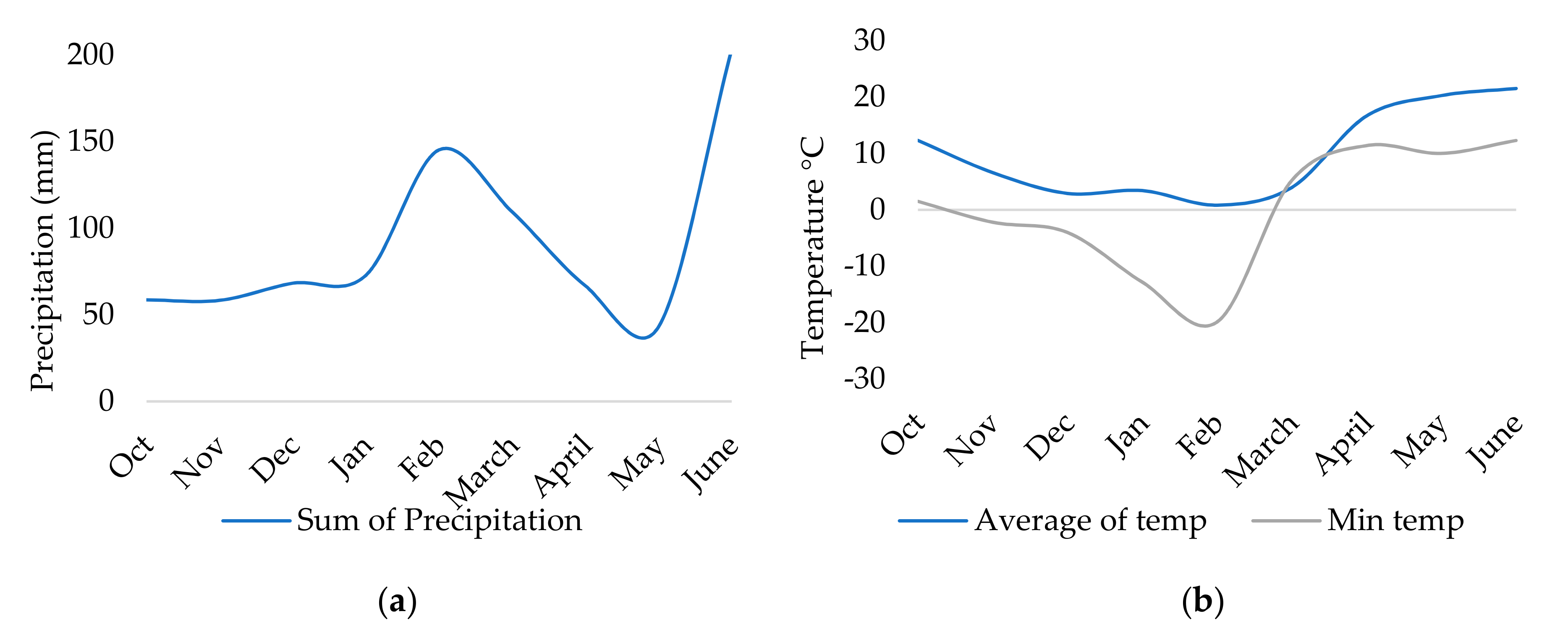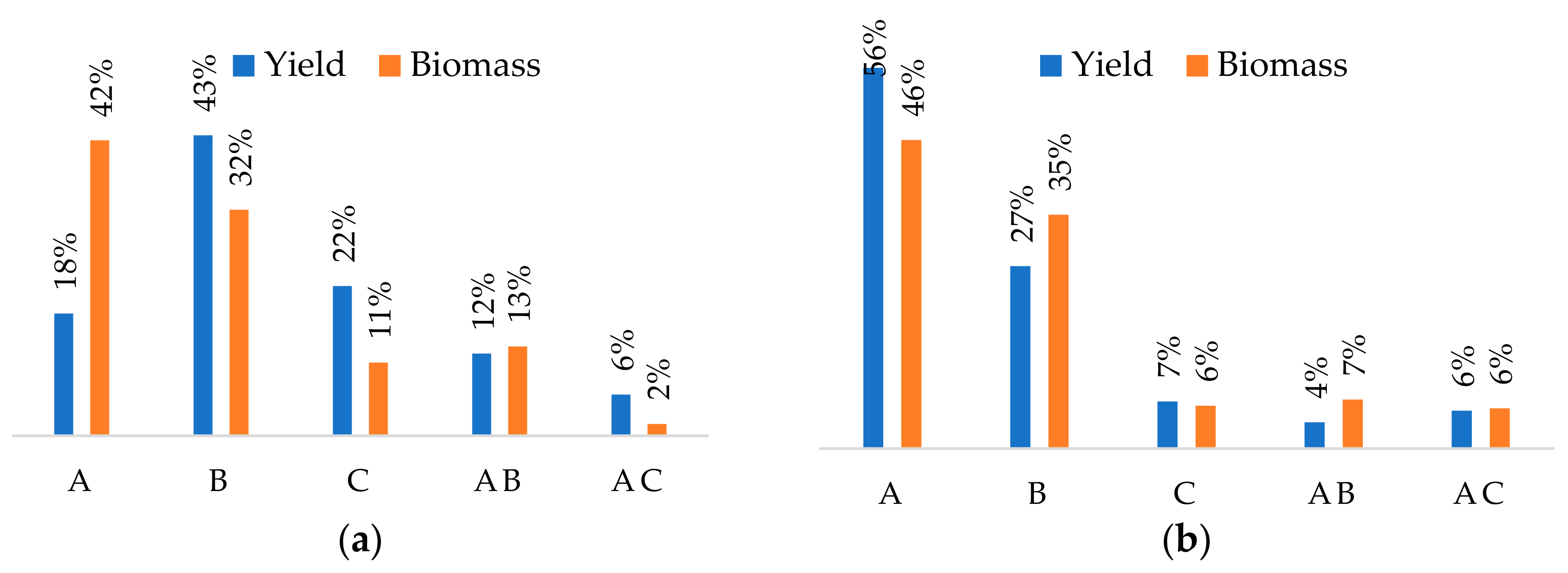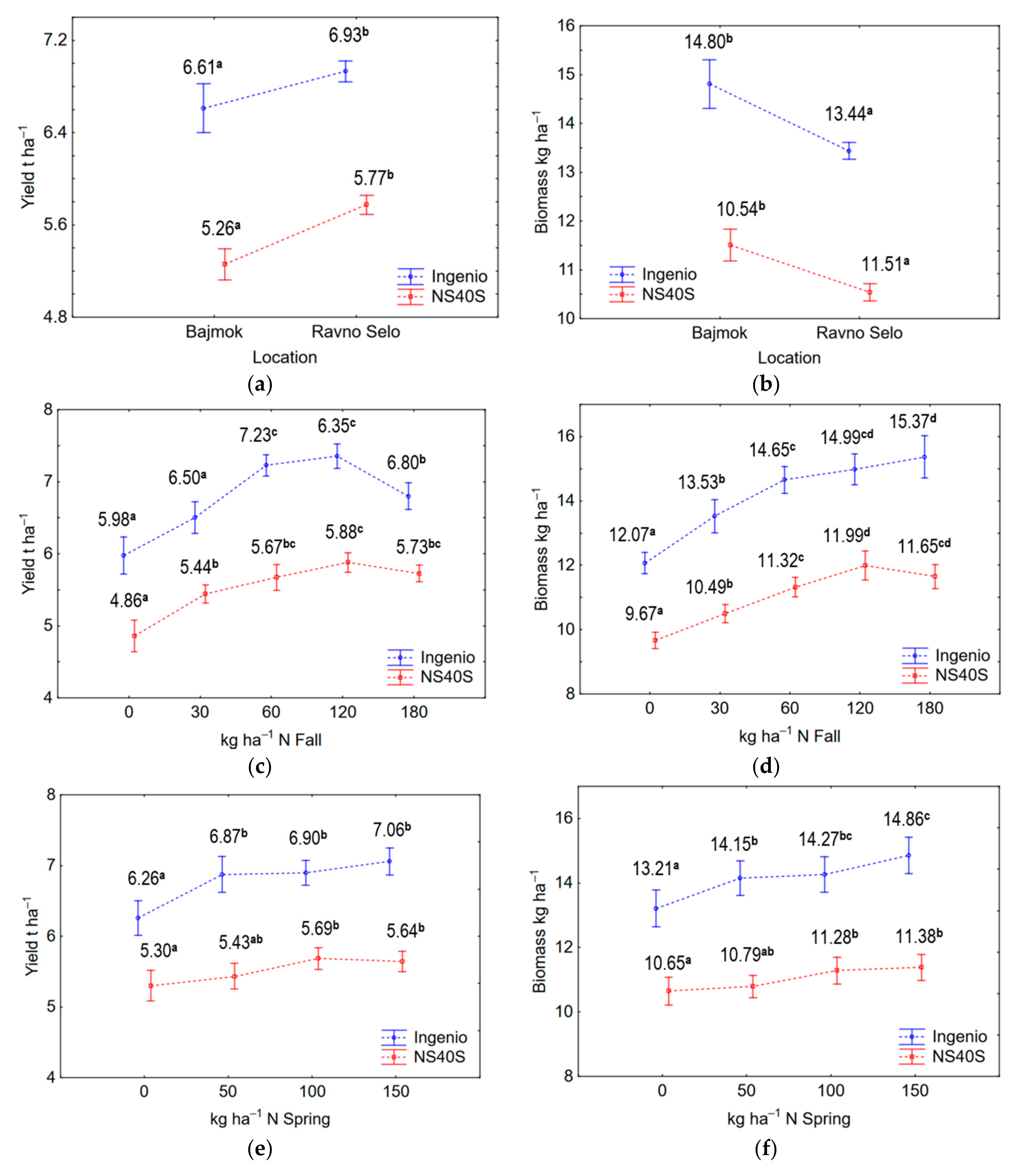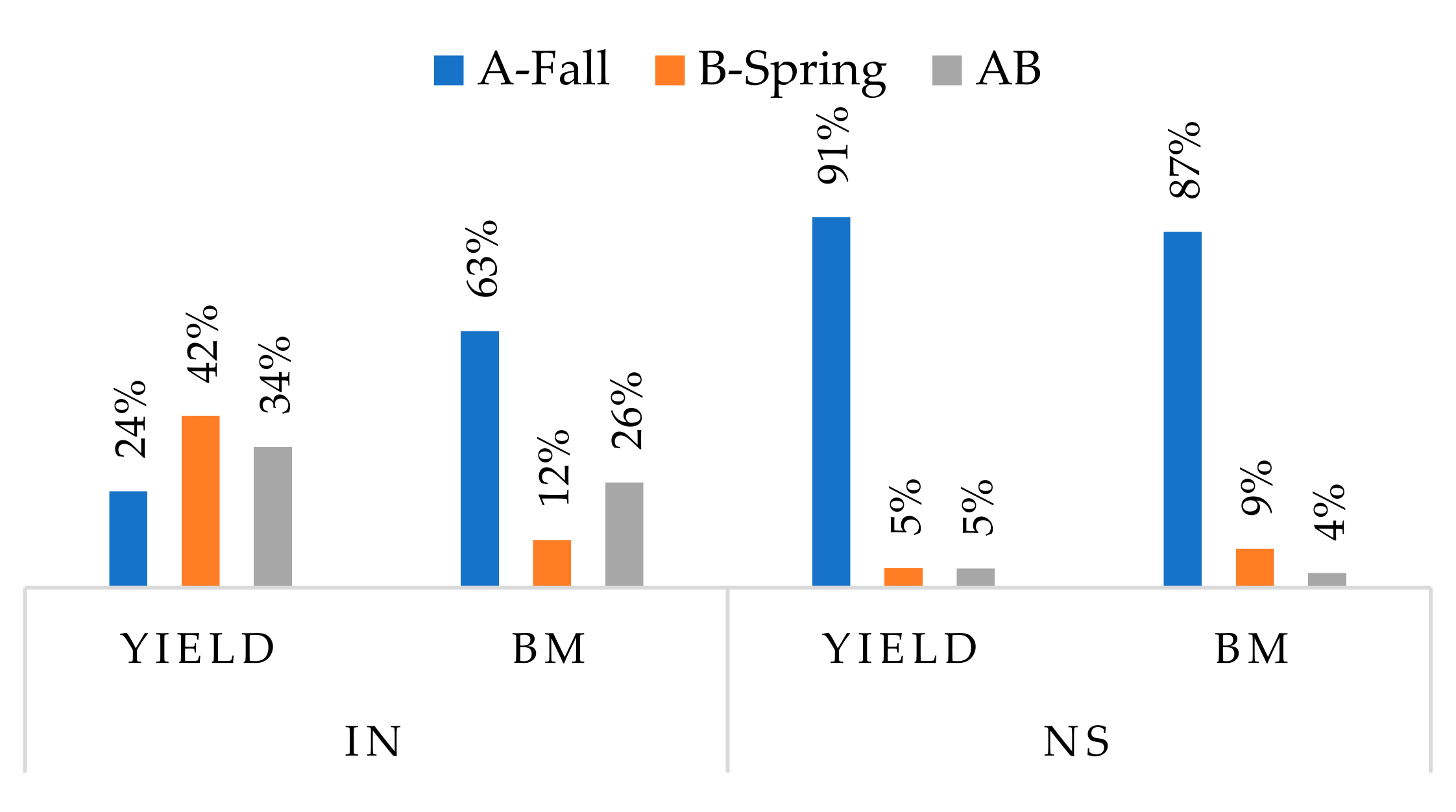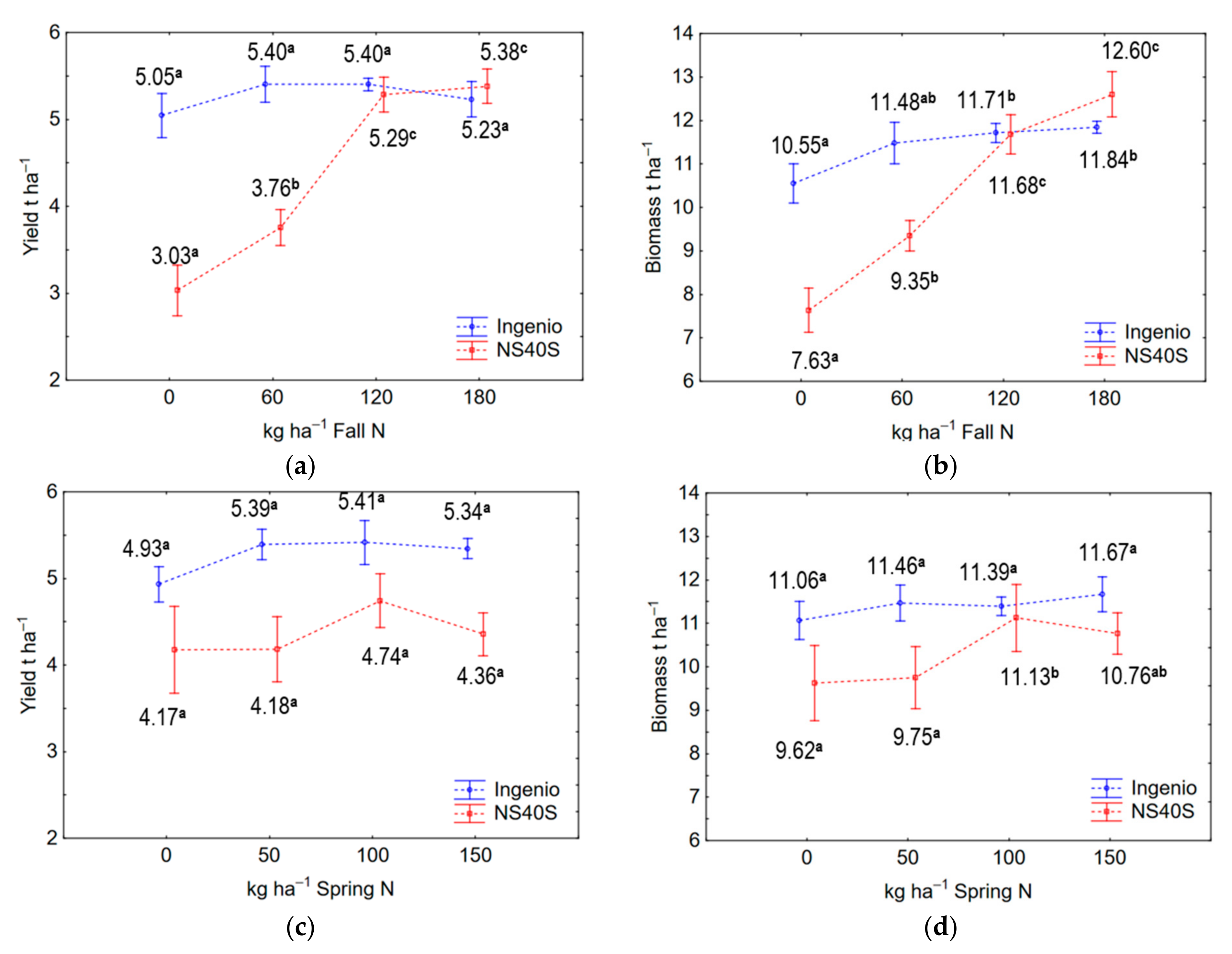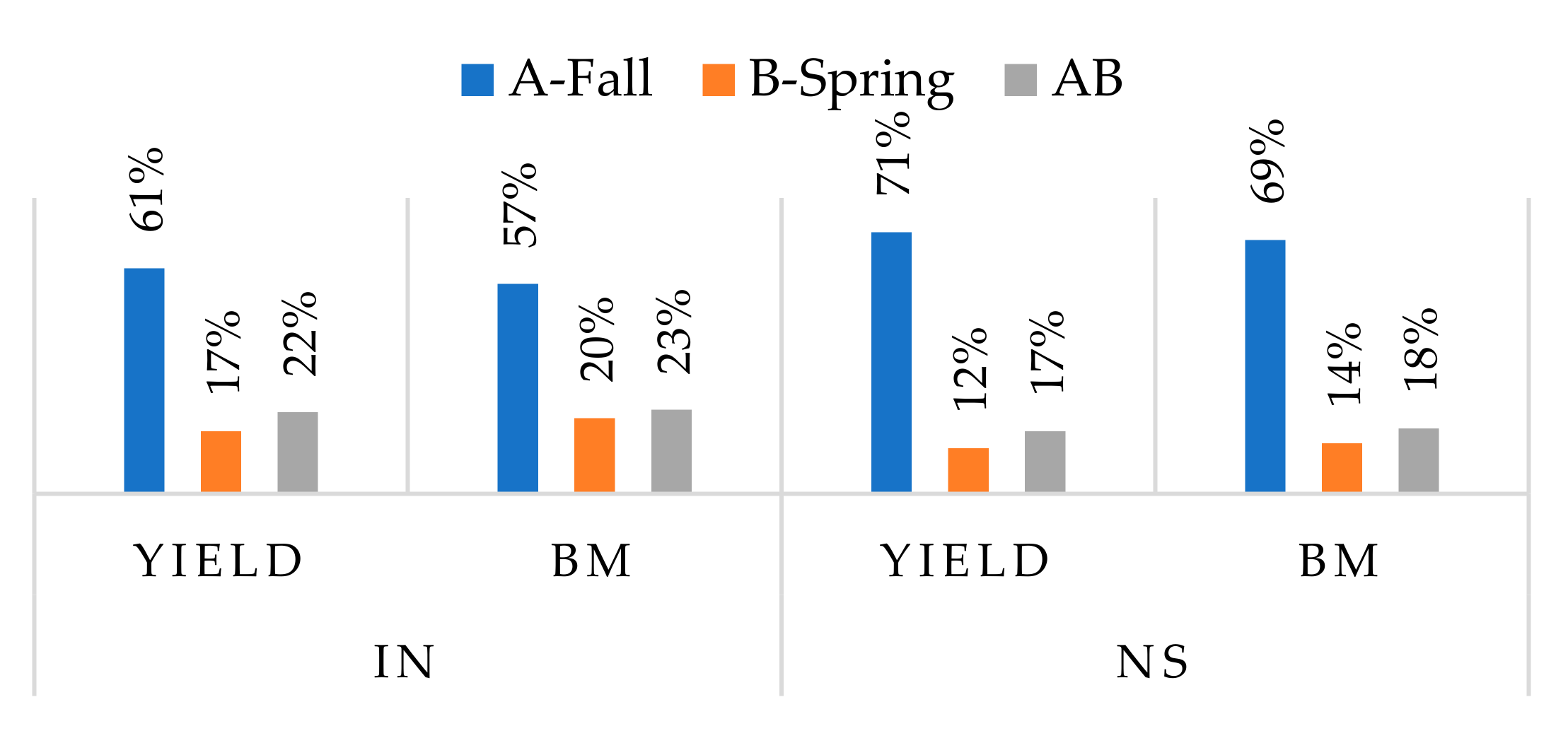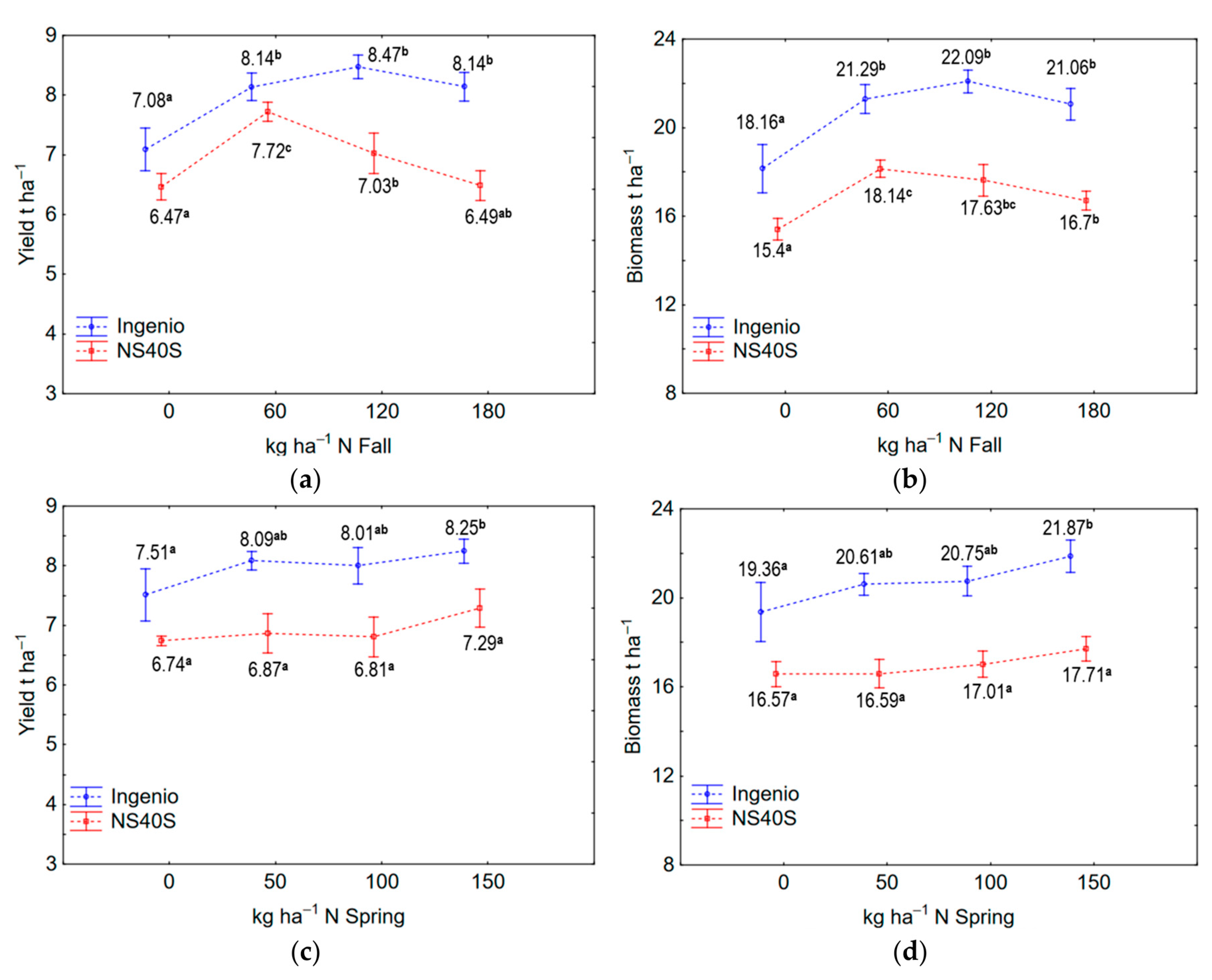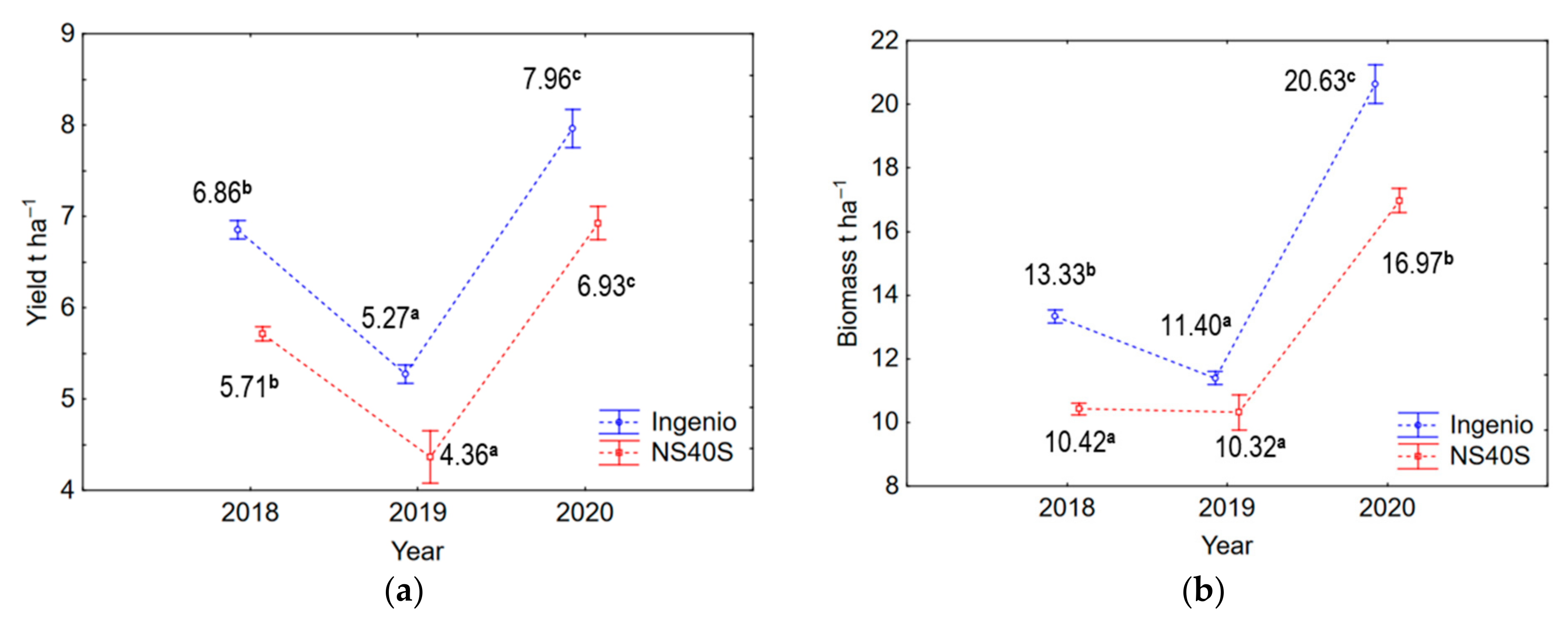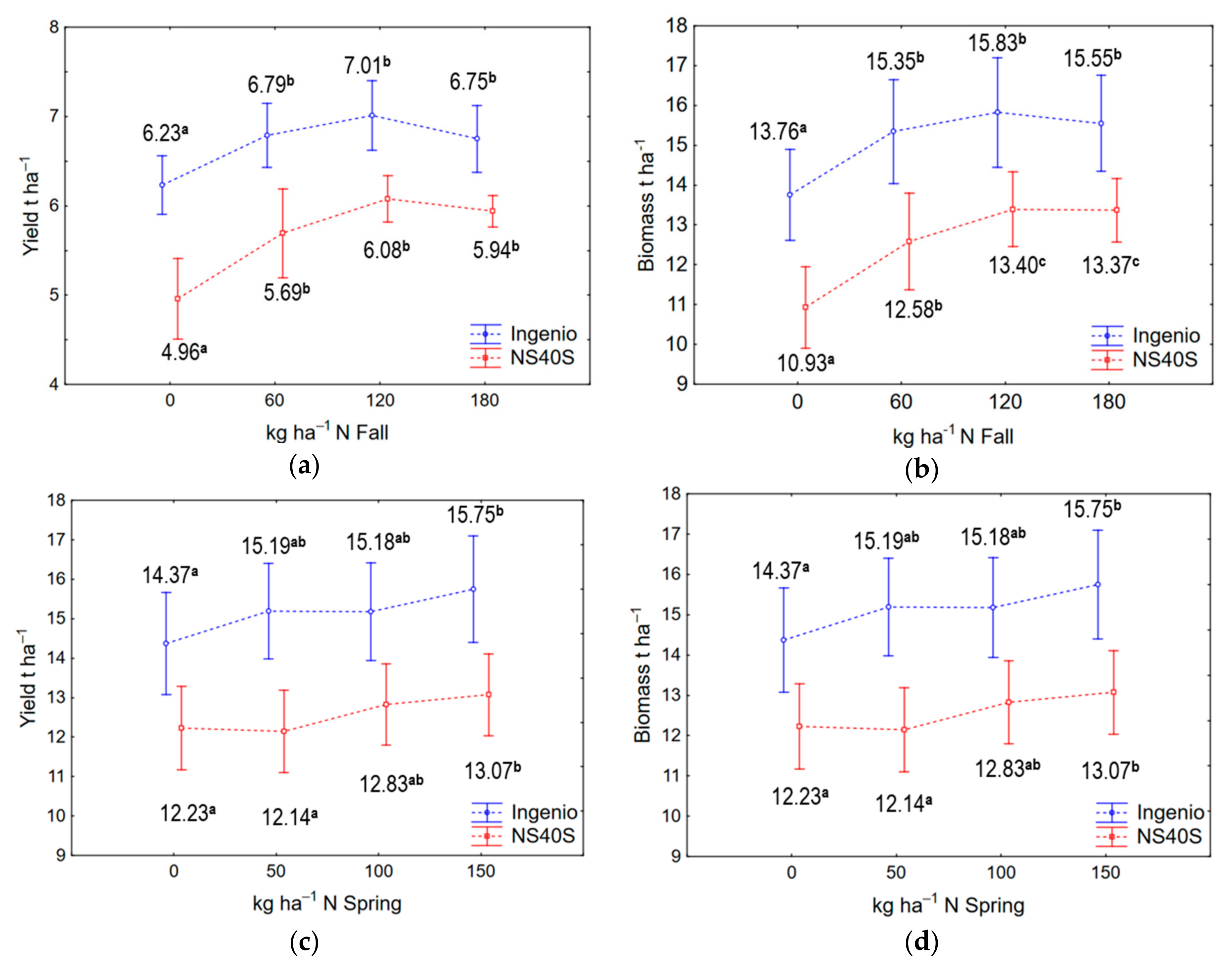1. Introduction
Cereals, and wheat specifically, are traditionally of the most important crops grown globally. This is reflected in the proportion of the total cultivated area occupied by these crops, in the total grain production and their participation in the world trade. The cultivated area shows fluctuations according to the market prices and the local agricultural policies. According to the food and agricultural organization of the United Nations (
http://www.fao.org/faostat/en/#data, accessed on 15 May 2020), despite the yearly fluctuations in the area cultivated with wheat, the total amount of produced grain is constantly increasing. This is attributed to the increasing trends of yield potential as a result of the better crop management and improved genetic material, which gradually increased the yields acquired by the farmers on a global basis. On the other hand, the fluctuations in the quantity of wheat grain produced in Serbia followed the trends of arable land covered with wheat crops (FAOSTAT, 2020). This indicates that wheat productivity remained at similar levels during the last 13-year period and thus, there is scope for yield improvement of wheat in Serbia.
In Serbia, for the period 2017–2019, winter wheat production occupied around 17% of total arable land [
1]. In the recent past, farmers preferred wheat due to its remedial effect on soil in the crop rotation cycle and positive contribution to pest control. Serbia is among the highest yielding wheat producers in the world (32nd out of 124 countries); however, in relation to European countries (rank 22/38), wheat yields in Serbia can be characterized as low [
2].
General projections imply that wheat yield must increase at least by 50% [
3] by 2050 with the existed or slightly reduced natural resources due to the expanding human population worldwide. Among all cereals, winter wheat can be characterized as one of the most nitrogen (N) demanding crops [
4]. However, Serbia uses approximately 600 kt of N fertilizer annually, which is relatively low compared to other parts of Europe [
5]. In Serbia, a uniform system it is still not established that regulates wheat trading on a farm-scale respecting grain protein content as a price leveling factor. Thus, farmers are strictly focused on reaching maximal grain yield.
Despite the established wheat quality market classes in developed countries, producers are also prone to grow high-yielding wheat varieties and, consequently, manage their resources in such a way to increase yield leading to lower protein content in the grain [
6]. Traditionally, in agricultural production, nitrogen fertilizer is the most utilized due to its well-proven, instantaneous and visible effect on plant appearance. Nowadays, annual nitrogen fertilizer consumption has reached 170 million tons worldwide, a multifold increase from the annual consumption in the early 1960s [
7,
8].
Increased N fertilizer application does not always imply an increase of grain yield; on the contrary, even a decrease in crop yields is seen in poorly managed production systems. Nitrogen application at the right amount contributes to higher yields by increasing the number of spikes and the number of kernels per spike [
9,
10]. Improper nitrogen management is environmentally hazardous and has an indirect negative impact on human and animal health. As [
11] showed, about 67% of total applied N fertilizer in wheat production could be lost because of natural processes like denitrification, leaching, volatilization (NH
3), and greenhouse gas (N
2O, NO or NO
2) emissions.
One of the methods for estimating nitrogen fertilizer utilization is defined by [
12] as the ratio of the gained yield and the amount of applied nitrogen fertilizer. Nitrogen utilization efficiency (NUE) is defined as the amount of grain produced per unit of N uptake at maturity [
13]. Several methods improve the efficiency of nitrogen fertilizers, and they are based on the knowledge of the yield potential, an adaptation of the N rate to soil organic matter content, and mineralization potential [
14] as environmental-related factors. The selection of fertilizer, the time of application and the method and the amount of fertilizer application are important aspects for minimizing nitrogen losses from the soil [
15]. The short-time dynamics of nitrogen content in the soil limits the possibility of assessing the site-specific optimal fertilization rate [
16] and time-specific roles for the adequate application of achieving the desired yield levels. Nitrogen stocks in the soil come largely from organic matter that bacteria transforms into an accessible form for plants to uptake. It is a part of soil material, and many essential compounds for plant life are contained therein, such as nucleic acids, proteins, enzymes, chlorophyll and others. The work of [
17] points out that the problems of mineral nutrition of wheat are of regional character, since the efficiency of applied quantities and nutrient ratios depends on numerous soil properties, specific climatic conditions, as well as cultivar specifics in terms of adoption to the environmental conditions, and uptake, transport and accumulation of minerals. The relationship between yield and NUE and factors influencing this interaction are still not completely investigated [
18].
Considering the rate of rapid climate change in the past decade, whose major implications directly affect open-sky agriculture, studies must be continued [
19] regionally towards the mitigation of its negative impact, by efficient and less environmentally hazardous management of any available resource. Nitrogen fertilizers are of the most utilized artificially produced chemical compounds in agriculture worldwide due to the importance of nitrogen in crop growth. Spatial and temporal dynamics of available N in the soil is strongly related to applied agronomic procedure is the appropriate assessment of NUE and its underlying components using methods that allow for fair comparisons across different crops, varieties, experimental setups and agroecological environments [
20]. In general, it is known that early N application may result in lower grain yield in comparison to mid-season sensor-based fertilization [
11]. The contribution of early, or mid-season N application and their combination, to grain yield and biomass of winter wheat, has not been adequately determined for chernozem soils.
Vojvodina is a traditionally agricultural region located in Northern Serbia. It is the southern part of the Pannonian region characterized by mainly flat landscapes and fertile soils. There are numerous soil types in the Vojvodina region, but chernozems predominate approximately 43% of the total arable land [
21]. Chernozem soils are very fertile with a high content of organic matter [
22].
The common agronomical practice in wheat production that most farmers follow is performing the split application of the N fertilizer in two or three doses. Starting with the basic fertilization, synthetic fertilizer in granular form is usually incorporated in the soil shortly before or at sowing (October 5–25th). A second fertilization is applied in spring (late February–early March) as the top-dress application of urea (46%) in granular form. Some farmers follow a second, top-dress application at the end of stem elongation (mid-April) as the optional fine-tuning correction of N (usually applying ammonium-nitrate). The amount of N is usually selected based on a regional agronomical recommendation without recognizing the annual variability in yield potential and crop response to N [
23]. Some farmers conduct early spring soil analysis to determine the residual nitrate in the soil and the potential for soil mineralization which is the basis for the N application recipe.
The main hypothesis of this study was that specific environmental conditions in Vojvodina region in combination with different genotypes and N timing application in three consecutive growing seasons affect the efficiency of the applied N fertilizer in winter wheat production. Thus, the study aimed to find optimal fertilization scheme that better fits the soil and climatic conditions in Vojvodina region. The experiment was set up accordingly to study which basic N application rate is more profitable, whether a second top-dress application at spring increases profitability, and at which rate, under variable weather conditions. This will be the basis for the development of automated N application systems adjusted to chernozem soils and to the special conditions of the Pannonian regions.
2. Materials and Methods
The study was conducted over a three-year period (2018–2020), at four commercial fields at different geographical locations with similar climatic conditions and different soil properties located in Ravno Selo and Bajmok, in central-west and northern Vojvodina, respectively. Therefore, the overall experiment was conducted at four site-years as summarized in
Table 1.
Two high-yielding cultivars of winter wheat (Triticum aestivum L.), widely grown in Serbia and other neighboring countries, were included in the study, namely: “NS40S” and “Ingenio”. The cultivar NS40S was released by the Institute of Field and Vegetable Crops, based in Novi Sad, in Serbia, while CCB Ingenio is an imported variety from Syngenta’s catalog (Syngenta, France). The cultivars were selected based on their variability in plant height, and grain yield potential and other characteristics; (a) NS40S is recommended as medium early, resistant to lodging, tolerant to drought, resistant to powdery mildew and leaf rust; (b) Ingenio is also medium early and resistant to lodging, resistant to Fusarium wilt and well adapted to the Serbian growing conditions. According to data from the Institute of Field and Vegetable Crops in Novi Sad, on average, for NS40S variety, based on multiyearyear average, grain yield increases from 4–6 t ha−1 in unfavorable conditions and more than 10 t ha−1 in favorable conditions. Regarding the Ingenio variety, during the introduction process, the average yield was 8.8 t ha−1, in some localities, the yield was above 10 t ha−1 in 2009, while in 2010 the average yield reached 7.7 t ha−1, and in some localities, it was exceeded 9 t ha−1 in production conditions.
The practices for soil preparation included conventional tillage (CT) with a moldboard plow at 20 cm depth, followed by a final soil consolidation using a combined cultivator to ensure uniform soil condition over the plots. As [
24] recognized, a lower intensity of soil tillage increased small-scale variation in nitrogen use efficiency. Sowing took place in the fall (October) using a 25-row wheat-seeder equipped with a single-disc furrow opener at 0.12 m distance between rows, which was calibrated to perform seeding rate of 500–550 seeds m
−2. The typical pest control approach was conducted in the trials, including early insecticide application after plant emergence (Alfa–cipermetrin 100 g L
−1), followed by herbicide application in early spring (metsulfuron metil 600 g kg
−1) simultaneously with the first fungicide treatment (Propikonazol 250 g L
−1), while at the beginning of flowering, the final pesticide application was performed for ear protection (Tebukonazol 133 g L
−1 + Prohloraz 267 g L
−1).
Based on the common farmers’ practice in the region, approximately 50 kg of N ha−1 are applied as basic fertilization at sowing and up to 150 kg of N ha−1 are top-dressed in spring. Some farmers also apply a second top-dress application depending on the weather conditions and plant nitrogen supply assessments, relying on farmers’ personal perception. The N rates applied in the study were arranged to cover from no application up to a rate two times higher than the commonly applied rate for both basic and top-dress application.
At site-years 1, 2 and 4, the plots were 2-m wide and 8-m long. Using small-sized plots helped minimize the within-plot variability. The basic N fertilizer application was hand-applied on the soil surface immediately after sowing, using pre-weighed labelled bags with the corresponding fertilizer quantity for each plot. During the spring top-dress application, the plots were split into four subplots sized 2 m by 2 m.
At site-year 3, the plots were larger, 3-m wide and 12 m-long, in order to accommodate the mechanical application of basic fertilizer. Shortly after sowing, a 3 m wide conventional wheat seeder (Majevica Ltd., Bačka Palanka, Serbia) was used, after properly calibrated, incorporating the corresponding rates of ammonium nitrate (urea 46% N) in granular form, in each plot. The same procedure was repeated for the second application in spring utilizing ammonium nitrate (34% N).
Soil sampling took place right after setting up the experimental plots and before fertilizer application to define the initial soil nutritional levels. A composite soil sample per field was taken, consisted of four subsamples, one from each plot of the corresponding treatment. Dichromate wet oxidation method proposed by [
25] was performed to determine soil humus content. Grain N concentration was multiplied by grain yield to obtain grain N uptake (kg ha
−1). Nitrogen use efficiency was computed using the difference method (
http://www.nue.okstate.edu/N_Fertilizers/NUE_definition.html, accessed on 16 May 2020) as defined in the following equation:
Harvest took place at the end of June or the beginning of July (
Table 2), depending on weather conditions when the plants reached full maturity and the grain moisture content was approximately 14%. The crop was hand-harvested, cutting the above surface biomass, including the grain from 1-m
2 areas located in the center of each subplot. The harvested samples were weighed in the field and placed in pre-labelled bags for further processing. The grain was manually threshed, and grain weight and the above-ground biomass were measured.
In the fall, at site-years 1 and 2, a full factorial design was followed with 4 replications and 5 rates of nitrogen fertilizer application starting from 0-N (control) up to 180 kg of N ha
−1 (0, 30, 60, 120, and 180 kg of N ha
−1). At site-year 3, the identical number of replications was conducted even so with 4 rates of nitrogen fertilizer (
Table 3). The experimental design at site-year 4 followed the previous year; however, the number of replications was reduced to three to make the experiment more manageable. With the changes of experiment design over time, we have strived to keep track of the experimental design used to obtain a given observation. Urea (46% N) was selected as the fertilizer to be applied in the fall since the local farmers widely adopt it as a good agricultural practice.
A spring top-dress application followed during the end of tillering and the beginning of stem elongation. The initial plots were split into four additional treatments of top-dress N starting with 0-N up to 150 kg of N ha
−1 in increments of 50 kg of N ha
−1 (
Table 3). Ammonium nitrogen form of fertilizer (34% N) has been chosen for spring top-dressing because ammonium ions are less subject to loosening of nitrogen to the atmosphere even under dry conditions.
The climate and weather data for the three years of study were acquired from the National Oceanic and Atmospheric Administration (NOAA) and analyzed to explain the results and behavior of the crop response to N fertilizer applications.
2.1. Statistical Analysis on the Influence of N on Wheat Production
As an adequate approach for the analysis of variations in wheat yield, a design of experiments (DOE) methodology was used. Using analysis of variance (ANOVA), particular contributions of main factors and interactions in the total influence on responses was calculated proportionally to the sum of squares, i.e., to mean square errors (in the case when degrees of freedoms of observed effect differs), while statistically significant influences were confirmed by
p-value (<0.05). In the research, the focus was on the determination of the influence of controlled factors on wheat yield and biomass. Full factorial design was used with a two-factor interaction (2FI) model [
26]. The influence of factors on yield traits was analyzed using “Design-Expert” software (version 11, Stat-Ease, Inc., Minneapolis, MN). Besides the influence of fall and spring fertilizer treatment on yield and biomass, variability caused by location, variety and year were studied. It was expected that a comprehensive analysis would show a significant impact yearly. So, in order to obtain more precise and noticeable results of the influence of the remaining factors on yield and biomass firstly were performed, then an analysis during the particular years for separated varieties and multiyear study after that.
Nitrogen fertilization management and cultivar selection are the main factors deteriorating yield potential. The results from the nitrogen fertilization experiments performed in the framework this study, are thoroughly discussed in the following subsections.
2.2. Soil Analyses Results
Comparing the soil characteristics, all four site-years showed similar pH levels. On the other hand, the rest of the measured soil parameters, showed considerable variations among site-years, as shown in
Table 4.
4. Conclusions
Arable land in the northern part of Serbia is considerably fertile, providing high yield potentials for wheat production even with poor fertilizer management. Nevertheless, high soil organic matter content makes the task of optimization of nitrogen management more difficult, due to temporal variability of soil nitrogen-releasing activities. In this study, it was observed that about 85% of seasonal fluctuations of yield and biomass production are caused by weather conditions. According to a multiyear study, the observed differences in response to applied nitrogen respecting grain and biomass production, suggest that foreign imported variety (Ingenio) demonstrated higher sensitivity to spring N fertilizer than domestic one (NS40S), and vice versa in the case of N fertilizer applied in fall. Fall N application (up to 120 kg ha−1) procured a reliable positive impact on yield and biomass.
The results do not support a rigid approach to the field practice of application of N fertilizer over time; hence it must be updated to respect the specifics of the grown genotypes. The spring N application had a low and unstable impact on wheat performance over the trial period, distinctive for specific genotype and environment conditions. For this reason, N fertilizer forms and application methods in the spring must be modified in such a way as to place or inject fertilizer directly into the soil, but it requires additional investment in new equipment, which would be the only cost-effective in the case of large farms. Low spring N utilization by the plants was also due to a relatively long rainfall absence from the time of spring top-dressing. According to this, the rainfall factor must be part of a holistic N management strategy on a global scale, although the forecast at the field level—especially during the spring season in the Vojvodina region—is quite unreliable, which leaves too much room for uncertainty. On clayey soils, under continental climate conditions, we suggest that 60–80% of the nitrogen in the form of urea should be applied in the fall, and the rest of nitrogen in the early spring by banding or dribbling liquid nitrogen fertilizer on the surface rather than broadcasting.
